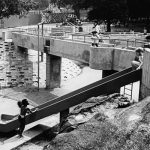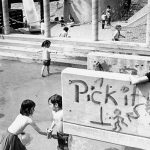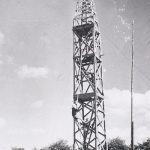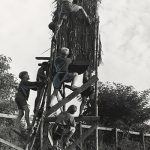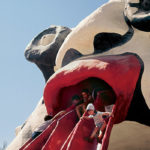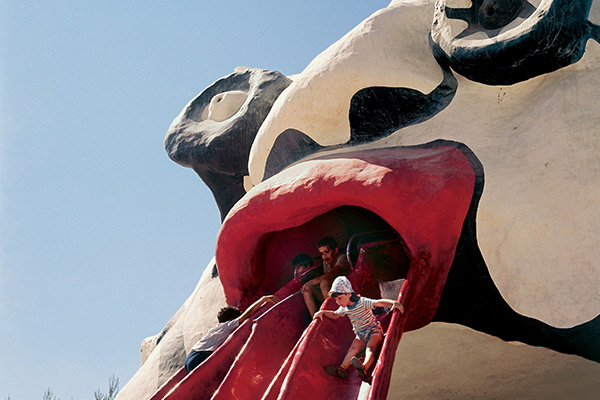
When play meant being free to experiment
In black and white photographs of a playground in Copenhagen circa 1940, all the kids are thrilled to be playing with junk.
It’s surplus bricks and lumber, but the children are obviously having the best time with those materials. This is a “junk playground,” designed by Carl Theodor Sorensen, who wanted to bring countryside recreation to the city. The number one rule of his playgrounds: No parents allowed. Only one adult was on hand to supervise, and it doesn’t look as if he or she put in any other rules. In one photo, the kids are clinging to the top of a four-story tower they built above who-knows-what – probably dirt. In another, they are clambering up and scaling the sheer sides of a homemade treehouse on stilts, also several stories tall.
“This was very radical,” says Jonathan Gaugler, giving a tour of these and similar displays in the “The Playground Project,” an exhibit of 40 years of playground design at the Carnegie Museum of Art.
Radical then? It would be even more radical now, in the era of padded playground surfaces, walkways enclosed in plastic, hovering parents and major lawsuits. The exhibit traces 40 years, from the 1940s to the 1970s, when playground design, like the kids who enjoyed them, seemed to run wild and unfettered.
“A playground is anything a child responds to in a creative ways and in unexpected ways,” says Gaugler, a museum spokesperson. “Playgrounds are where children try new things. What have we lost in an emphasis on a different way of thinking about risk?”
Where do the children play?
The exhibit is part of the 2103 Carnegie International, set to open Oct. 5. Play is an important impetus for art, of course. Guest curator Gabriela Burkhalter says her historic approach to the subject of play is meant to remind adults of the way they used to play and the places they used to visit as children. The Lozziwurm, built in 1972 and installed in front of the museum for parts of this summer and fall, has even allowed kids to experience a bit of old-school freestyle play.
Most of the displays are simple: photos mounted on plywood, two un-built playground models, all flanked by videos of children frolicking in these old-style play settings. One of the videos is projected nearly life size on a wall. There, in a Swiss park, kids are sliding down concrete forms, climbing through them and jumping off. It’s enough to make a current parent’s heart stop.
That’s why the exhibit asks several critical questions, says Burkhalter: “What play opportunities do we offer to children today? We pretend to do the best for our children, but is this really true? Don’t we overprotect our children just to protect ourselves?”
At the exhibit’s entrance are two interlocking “play panels,” each resembling a colorful house of cockeyed cards outfitted with slots and tabs for stability. They were designed by Richard Dattner in the 1960s and ’70s to be built by anyone. Dattner also designed several Central Park playgrounds for New York, including one at West 67th Street, with concrete and granite pyramids, tunnels and volcanoes, a wooden climbing structure and a treehouse, all with input from neighborhood parents and kids.
Playing with sculptures
Play structures, even sculptures, were an early playground movement, treating the entire play environment as an art object. French artist Niki de Saint Phalle, for instance, painted wild faces and symbols across giant creatures whose tongues were slides, and whose interiors provided playhouses.
Mitsuru Senda in Japan built massive environments; one that looks like an industrial landscape from above has towers with ropes slung between them, a low dome with a lattice of rope and climbing blocks. Another is a circuit, with steps and other obstacles to navigate, including a wormlike structure. He also built abstract sculptures for play; as Gaugler describes one, “It’s an egg with holes and ropes, but kids know what to do.”
Joseph Brown, a boxing coach and Princeton professor in the 1950s, felt that when kids played, they should be given elements of unpredictability, perhaps even be thrown off balance. His rope structures shifted as each new child jumped on – like the ropes around a boxing ring.
Adventure playgrounds were another trend. While outdoor play 100 years ago stressed physical fitness, these adventure playgrounds were about kids building their own play environments. Sorenson was just one adherent. Lady Allen of Hurtwood adapted bombed-out churches to playgrounds in England after World War II, based on her personal motto, “Better a broken bone than a broken spirit.” Photographs of the site look like a slum, but with happy kids who have built their own two-story climbing structure/cabin.
Landscape playground designers took topography and made micro-environments using water, sand and other natural features. Landscape playground pioneer Isamu Noguchi made playgrounds from mounds and cutaways.
“There’s no play equipment here,” Gaugler points out, “no monkey bars or swings. It’s just these surfaces that allow for climbing, running, hiding and sliding – all the things you do in a playground.”
DIY playgrounds
All of these movements culminated in the do-it-yourself trend of the 1970s, embodied in a small bookshelf on display with such titles as Playgrounds for Free, Housebuilding for Childrenand Make Your Backyard More Interesting Than T.V.
“Indoor playgrounds or private backyard playgrounds have partly taken over the role of the public playground,” Burkhalter acknowledges. “But public playgrounds or street play are social gathering spots fostering children’s social skills. Private play opportunities can’t replace this aspect. It is essential to promote the public aspect of play, allow access to play and creativity to all children.
“I see a promising role in the ‘Green Schoolyard Movement,'” she allows. “It’s idea is to green school grounds and make them accessible as learning and play space.”
But she doesn’t see any echoes of the old playground movements still in place around Pittsburgh.
“Blue Slide Park might be the best we have,” says Gaugler, referring to Frick Parklet on Beechwood Boulevard in Squirrel Hill, known for its long blue-painted concrete slide built into the hillside from the upper level of the park to the lower. “Blue Slide Park is kind of an anomaly.”
Before heading home, a visitor may catch a glimpse of the museum’s ARTventures space beside Dattner’s “play panels.” These rooms are open for families every day from 12:30 to 4:30 p.m. (and until 7:30 on Thursday evenings). There, ARTventures staff have been encouraging children to design their own playgrounds. The walls display their efforts.
Besides the usual playground apparatus, the kids have drawn playground features they’d like to see. There is a drawbridge with alligators and a “wipeout course,” presumably to stimulate falls and collisions in car-less car wrecks. There is “Crazyland,” a combination of jungle gym, swings and steps at odd angles, a resident robot and a tube cannon to shoot balls across the playground.
Maybe these old playgrounds have a future after all.
“The Playground Project” closes temporarily on Aug. 11, then re-opens Oct. 5 with the International.
Photographs provided by Carnegie Museum of Art.
